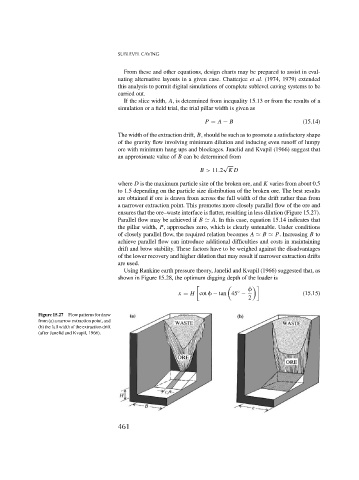Page 479 - Rock Mechanics For Underground Mining
P. 479
SUBLEVEL CAVING
From these and other equations, design charts may be prepared to assist in eval-
uating alternative layouts in a given case. Chatterjee et al. (1974, 1979) extended
this analysis to permit digital simulations of complete sublevel caving systems to be
carried out.
If the slice width, A, is determined from inequality 15.13 or from the results of a
simulation or a field trial, the trial pillar width is given as
P = A − B (15.14)
The width of the extraction drift, B, should be such as to promote a satisfactory shape
of the gravity flow involving minimum dilution and inducing even runoff of lumpy
ore with minimum hang ups and blockages. Janelid and Kvapil (1966) suggest that
an approximate value of B can be determined from
√
B > 11.2 KD
where D is the maximum particle size of the broken ore, and K varies from about 0.5
to 1.5 depending on the particle size distribution of the broken ore. The best results
are obtained if ore is drawn from across the full width of the drift rather than from
a narrower extraction point. This promotes more closely parallel flow of the ore and
ensures that the ore–waste interface is flatter, resulting in less dilution (Figure 15.27).
Parallel flow may be achieved if B A. In this case, equation 15.14 indicates that
the pillar width, P, approaches zero, which is clearly untenable. Under conditions
of closely parallel flow, the required relation becomes A B P. Increasing B to
achieve parallel flow can introduce additional difficulties and costs in maintaining
drift and brow stability. These factors have to be weighed against the disadvantages
of the lower recovery and higher dilution that may result if narrower extraction drifts
are used.
Using Rankine earth pressure theory, Janelid and Kvapil (1966) suggested that, as
shown in Figure 15.28, the optimum digging depth of the loader is
◦
x = H cot − tan 45 − (15.15)
2
Figure15.27 Flowpatternsfordraw
from (a) a narrow extraction point, and
(b) the full width of the extraction drift
(after Janelid and Kvapil, 1966).
461

